新人教版八年级英语下册Unit2 教学设计2
- 格式:doc
- 大小:1.03 MB
- 文档页数:2
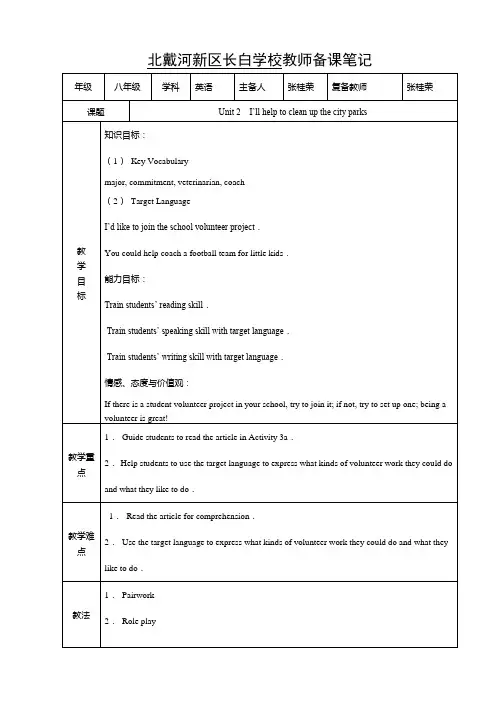

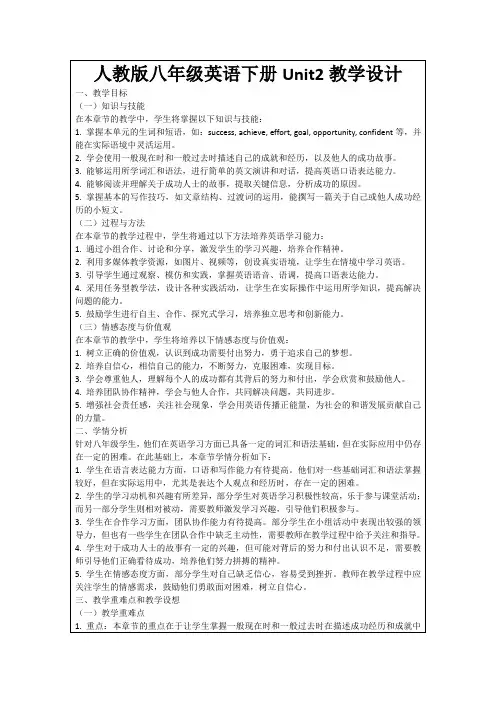
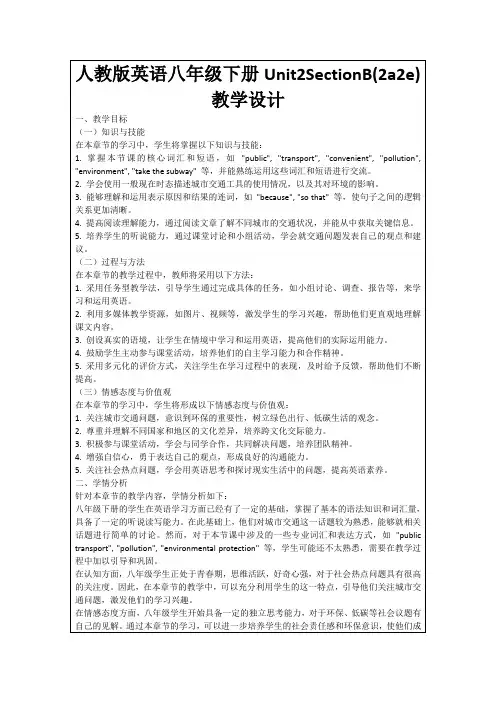
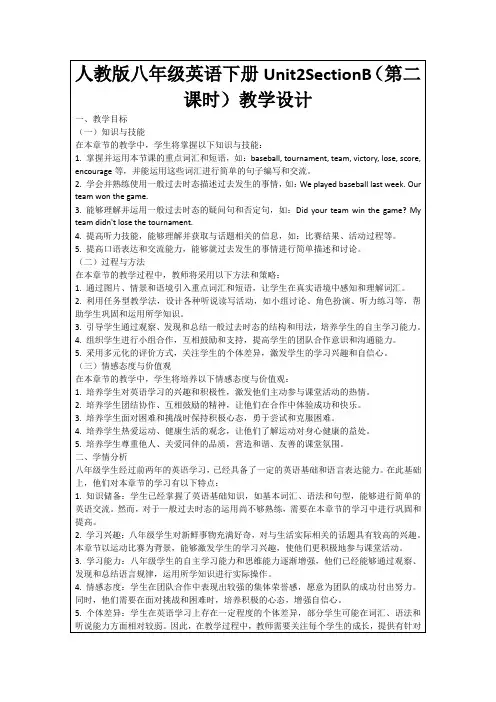

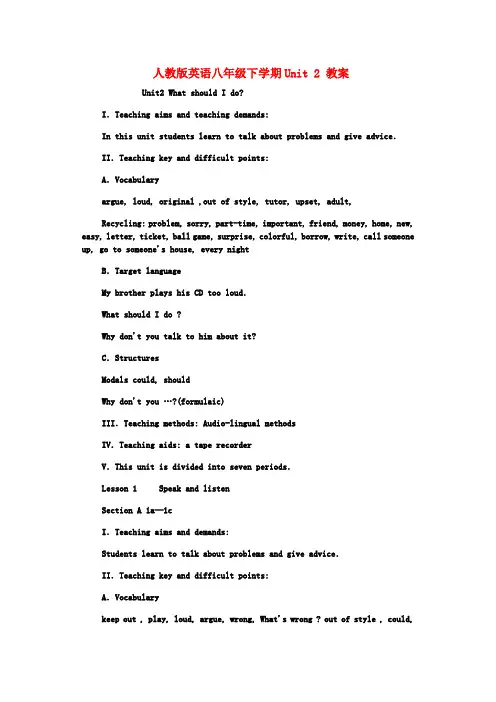
人教版英语八年级下学期Unit 2 教案Unit2 What should I do?I.Teaching aims and teaching demands:In this unit students learn to talk about problems and give advice.II.Teaching key and difficult points:A.Vocabularyargue, loud, original ,out of style, tutor, upset, adult,Recycling: problem, sorry, part-time, important, friend, money, home, new, easy, letter, ticket, ball game, surprise, colorful, borrow, write, call someone up, go to someone's house, every nightB.Target languageMy brother plays his CD too loud.What should I do ?Why don't you talk to him about it?C.StructuresModals could, shouldWhy don't you …?(formulaic)III.Teaching methods: Audio-lingual methodsIV.Teaching aids: a tape recorderV.This unit is divided into seven periods.Lesson 1 Speak and listenSection A 1a─1cI.Teaching aims and demands:Students learn to talk about problems and give advice.II.Teaching key and difficult points:A.Vocabularykeep out , play, loud, argue, wrong, What's wrong ? out of style , could,should,B.Target languageMy brother plays his CDs too loud.Maybe you should buy some new clothes.III.Teaching methods: Audio-lingual methodsIV.Teaching aids: a tape recorderV.Teaching procedureActivity 1.RevisionTask 1.DictationTask 2.Ask and answer.Questions about future with will.Activity 2.PresentationThis activity introduces some new vocabulary.Task 1 .Make a two-column chart on the board with the heading Problem at the top of column 1 and the heading Advice at the top of column 2 .Then ask the students to tell you what you could do about it.ProblemI want to buy a new guitar but I don't have enough money.Advice1.Wait until next year.2.Don't buy a guitar.3.Borrow one.4.Buy a used guitar.5.Get a part-time job.Task 2.Then read the problem to the class again.Then write the words could ,should ,and shouldn't on the board next to the chart.Read the problem to the class again and help the class give advice using the words could, should ,and shouldn't.Task 3.Ask the students to finish the task in 1a.Teach : Serious problem is a very bad problem, a very big problem.Out ofstyle means not in fashion.enough money : I don't have enough money to buy a bike.Ask the students to write the problems in the serious or Not serious column.Task 4.Talk about the answers.A sk ,Who put “My parents want me to stay at home every night?” the serious column? Ask the same questions about the other items.Discuss which problems students thought were the most serious.Activity3.Listen and circle the problems you hear in activity 1a.Task 1.Point to the pictures in activity 1a.Ask different students to say what they see in each picture.Read the instructions to students.Task 2.Play the recording the first time.Students only listen.Task 3.Play the recording a second time.Students circle the problems they hear.Then check the answers.Activity4.PairworkAsk the students to look at the problems in activity 1a and make conversations.Homework1.Make up your own conversations.2.Make ten sentences with could, should and shouldn't.Lesson 2 Listen and speakSection A 2a─Grammar FocusI.Teaching aims and demands :Students learn to talk about problems and give advice.II.Teaching key and difficult points:A.Vocabularycall sb.up, ticket, surprise, on the phone, What's the matter?B.Target languageYou could go to his house.You could give him a ticket to a ball game.What should I /he/they do ?III.Teaching methods: Audio-lingual methods and PPPIV.Teaching aids: a tape recorderV.Teaching procedureActivity 1.RevisionTask1.Check the homework.Ask and answer.Task2.Revise the vocabulary.Activity 2.Listening and circling .Task1.Read the instructions.Learn the key vocabulary.Read and repeat the phrases.Task2.You will hear a conversation between Nari and a friend.Play the recording twice and students circle the word ,Nari's friend uses to give advice.Then check the answers.Activity 3.ListeningTask 1.Read the instructions.Show students the example match.Task 2.Play the recording again and check the answers.Activity 4.GroupworkTask 1.Read the instructions for the activity.Task 2.Point to the example in the sample dialogue.Ask two students to read the conversation to class.Task 3.Ask students to role play a conversation between Nari and his friend using these two sets of sentences.Then have the students work in pairs.Task 4.Check the answers by calling on different pairs to say a conversation to the class.Activity 5.Grammar FocusReview the grammar box.ask the students to say the questions and the responses.Explain that the word should is always used to ask for advice, butthe words could, should, and shouldn't are used to give advice.Could is a less serious word than should.Pay attention to the questions and answers, ask and answer loudly.Homework1.Review the conversation and the vocabulary.2.Write your own conversations on giving advice.Lesson 3 Reading and writingI.Teaching aims and demands :Students learn to talk about problems and give advice.II.Teaching key and difficult points:A.Vocabularypay for, part-time job, okay, either, bake, Teen Talk, tutor, need, maybe, good idea, bad idea, okay ideaB.Target languageWhat should I do ?Then I think you should get a part- time job.III.Teaching methods: Audio-lingual methods and Control-reading and writing.IV.Teaching aids: a pictureV.Teaching procedureActivity 1.RevisionTask 1.Revise the vocabulary and the key structures.Task 2.Dictation.Activity 2.Reading and writingTask 1 .Read the instructions.Write the possible responses on the Bb and ask a student to read the responses to the class.Discuss the three responses and be sure students understand how the responses are used.Task 2.Ask four students to read the conversation to the class.Ask the students to fill in the blank.Then ask and answer in groups.Activity 3.PairworkTask 1.Read the instructions.And then ask two students to read the sample conversationn.Task2.Ask the students to say some ways to get money that aren't in the book.Task 3.ask the students to work with partners as they ask for and give advice.Then ask two or three pairs of the students to say their conversations to the class.Activity 4.PairworkThis activity provides an opportunity for students to use the language of the unit to give advice.Task 1.Read the instructions.Then ask two students to read the dialogue.Task 2.Ask another pair of students to give their advice on another topic.Pick a topic of current interest in the news.Homework1.Review the vocabulary and target language.2.Write your own conversations about problems and advice.Lesson 4 Section BI.Teaching aims and demands :Students practice using the target language.II.Teaching key and difficult points:A.Vocabularyoriginal , the same as, in style, nicer, haircut, inexpensive, comfortableB.Target languageI think Erin should tell her friend to get different clothes.Friends shouldn't wear the same clothes.They are the same as my friend's clothes.III.Teaching methods: Audio-lingual methodsIV.Teaching aids: a tape recorderV.Teaching procedureActivity 1.RevisionThis activity introduces the key vocabulary.Task 1.Read the instructions in 1a.Ask a student to read the sentences to the class.Read each sentence again and ask the Ss to repeat it.Then explain in their own words that each sentence means.For example:T: What does original mean?S1: Different from others.Not the same.T: Correct.When something is original, it is not like all the others.Can you give an example?S1:My watch doesn't have numbers on it.It has pictures of faces instead of numbers.My watch is original.T: Correct.It's not like all the others.Task 2.Point out the write-in line in front of each sentence.write VI if the statement is very important to you, write I if the statement is somewhat important to you, and write NI if it is not important.Task 3.Talk about the answers with the class.Activity 2.ListeningTask 1.Read the instructions.Point to the three items students will be listening for:Say you will be listening to a radio advice program.People call in for help with a problem and other people call up with advice.They will be talking about one of these problems.Please chech the problem they talk about.Task 2.Play the recording the first time.Students only listen.Task 3.Play the recording a second time.Ask the students to put a check in front of these problems.Then check the answer.Activity 3.Listening and writingA.Listen carefully and fill in the chart with the advice that you hear .Then check the answers .B.Listen again and fill in the chart.Then check the answers.Activity 4.PairworkTask 1.Read the instructions.Task 2.Ask two students to read the conversation to the class.Task 3.Work with the partners and say what do you think Erin should do.Ask some pairs of students to say part of their conversation to the class.Homework1.Review the vocabulary .2.Write your own conversations about advice.Lesson 5 Reading and writingI.Teaching aims and demands :Students practice the target language by reading and writing.II.Teaching key and difficult points:A.Vocabularyexcept, upset, find out, do wrong, what to do, lonely, argueB.Target languageWhat should I do ?You could be more friendly.You should try to be funny.Everyone else in my class was invited except me.I'm very upset and don't know what to do.I just found out that my friends were planning a birthday party for my best friend,…III.Teaching methods: Audio-lingual methods and Control-writing.IV.Teaching aids: a tape recorderV.Teaching procedureStep 1.RevisionTask1.Check the homework.Ask and answer.Task2.Revise the vocabulary.Step 2.Reading and writingTask 1.Teach these words:except: Everyone has a bike except Jim.Everyone has a bike besides Jim.find out: learn, Please find out where they live.I can't think what I did wrong.I don't know what to do.Task 2.Ask the students to read the instructions.Task 3.Ask the students to read the letter and underline the problem on their own.Correct the answers.Step 3.WritingTask 1.Read the instructions.Ask a student to say some of the advice they might give.Write the key words on the board.Task 2.Ask the students to write the letters on their own.Task 3.Ask some students to read their letters to the class.Step 4.Writing on your own.1.read the instructions.2.ask the students to say some problems they might write about.3.ask some students to read their letters.Step 5.Groupwork1.Ask the students to read the instructions.2.Ask two students to read the dialogue.3.Ask another pair of students to give their advice for one of the problems.4.Ask students to complete the work in groups.5.Ask a few students to share the sample conversations.Step 6.Self Check1.Ask the students to do the exercises on their own .Then check the answers.2.Read the letter and then write some advice.3.Ask a few students to read their letters of advice.4.Just for fun.Ask two students to read the conversation to the class.Homework1.Review the vocabulary .2.Finish off the writing exercises.Lesson 6 Reading and writingI.Teaching aims and demands :Students learn to master the reading skills.II.Teaching key and difficult points:A.Vocabularyuntil, fit, as much as possible, pressure, complain, include, pushy, send, all kinds of, compare, crazy, adult, on the one hand, …organized, on the other hand,…B.Target languageWhat should you do to relax?Parents should learn to give their kids a bit more time to themselves.III.Teaching methods: Audio-lingual methods and Control-reading and writing.IV.Teaching aids: a tape-playerV.Teaching procedureActivity 1.RevisionTask 1.Revise the vocabulary and the key structures.Task 2.Dictation.Activity 2.Before You ReadTask 1 .Read the instructions.1.Encourage the students to think about life outside school hours.List them on the Bb.2.Ask the students to use the list on the Bb to complete the two boxes labeled “I do”, and “I don't do”.They are free to add any ore activities they do, or don't currently.3.Ask a few students to share what they have written.Task 2.Teach the students about using a dictionary.1.Explain that a dictionary can help students learn independently.They can learn new words, how to pronounce them, and how to use them correctly.2.Let the students to look up the words in the box.3.Have a brief memory quiz on all the words.4.Discuss the points made in the Reading Strategy about using a bilingual ,learner's and electronic dictionary.Activity 3.While You ReadingTask 1.Ask the students to read and notice the words they have just looked up in their dictionaries.Read the sentences to the class.Task2.Ask the students to read the passage loudly .Homework1.Review the vocabulary and target language.2.Write your own conversations about problems and advice.Lesson 7 Reading and writeI.Teaching aims and demands :Students learn to master the reading skills.II.Teaching key and difficult points:A.Vocabularyuntil, fit, as much as possible, pressure, complain, include, pushy, send, all kinds of, compare, crazy, adult, on the one hand, …organized, on the other hand,…B.Target languageWhat should you do to relax?Parents should learn to give their kids a bit more time to themselves.III.Teaching methods: Audio-lingual methods and Control-reading and writing.IV.Teaching aids: a tape-playerV.Teaching procedureActivity 1.RevisionTask 1.Dictation.Task 2.Read the passage to the class.Activity 2.After You ReadTask 1.Read the statements.Task 2.Discuss with your partners.Task 3.Ask each group to report their ideas to the class.Activity 3.writingAsk the students to write a sentence of their own using the words from the box in Section1b.Activity 4.WritingTask 1.Read the instructions.Task 2.Review language used for advice.Then imagine you are Dr Alice Green.Write a letter to Cathy Taylor.Give advice about what she should do with her children.Activity 5.Go for it !1.Write Pressure on the Bb.Make a survey with two questions:When do you feel under pressure?What should you do to relax?2.If there is someone in your class who has a big problem, make a plan to help them.Homework1.Review the vocabulary .2.Finish writing the letter.。
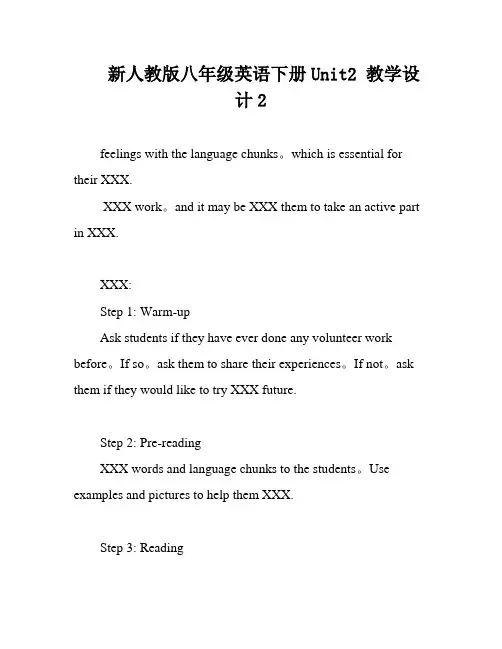
新人教版八年级英语下册Unit2 教学设计2feelings with the language chunks。
which is essential for their XXX.XXX work。
and it may be XXX them to take an active part in XXX.XXX:Step 1: Warm-upAsk students if they have ever done any volunteer work before。
If so。
ask them to share their experiences。
If not。
ask them if they would like to try XXX future.Step 2: Pre-readingXXX words and language chunks to the students。
Use examples and pictures to help them XXX.Step 3: ReadingHave students read the article 3a about a boy named Andy who XXX the new words and language chunks they have learned.Step 4: Post-readingAsk students to discuss the XXX groups:What did Andy do as a XXX?Why did Andy want to be an animal doctor?How did Andy's volunteer work help him to achieve his future dream job?XXX。
Why or why not?Step 5: Language practiceHave students use the new words and language chunks to create their own XXX.Step 6: HomeworkAsk students to write a short XXX they have had or would like to have in the future.In n。
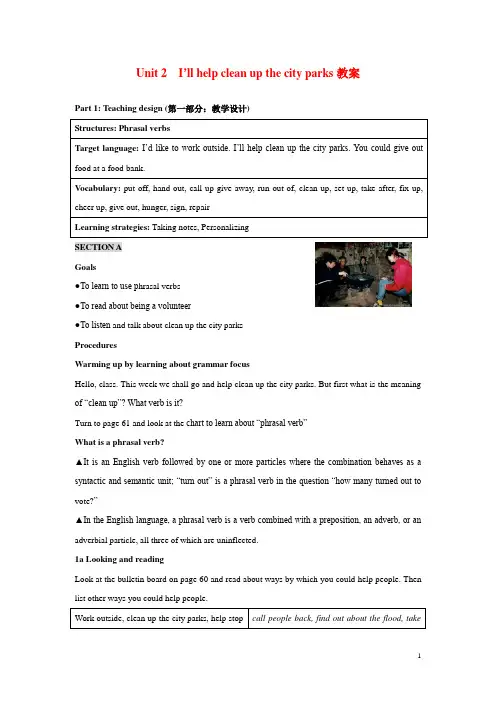
Unit 2 I’ll help clean up the city parks教案Part 1: Teaching design (第一部分:教学设计)SECTION AGoals●To learn to use p hrasal verbs●To read about being a volunteer●To listen and talk about clean up the city parksProceduresWarming up by learning about grammar focusHello, class. This week we shall go and help clean up the city parks. But first what is the meaning of “clean up”? What verb is it?Turn to page 61 and look at the chart to learn about “phrasal verb”What is a phrasal verb?▲It is an English verb followed by one or more particles where the combination behaves as a syntactic and semantic unit; “turn out” is a phrasal verb in the question “how many turned out to vote?”▲In the English language, a phrasal verb is a verb combined with a preposition, an adverb, or an adverbial particle, all three of which are uninflected.1a Looking and readingLook at the bulletin board on page 60 and read about ways by which you could help people. Then list other ways you could help people.1b Listening and completingYou are going to listen to several conversations.While listening, pay attention to information to complete the sentences on page 60 in the box.1c Doing pairworkIn pairs you are to practice the conversations in the picture on page 60. Then make similar conversations using the information in activity 1b.We could help stop hunger by giving out food2a Listening and checkingSome students talking about planning a City Parks Clean-up Day. Listen to their talk and check√the things they are going to do.2b Listening and filling in blanksI’ shall play t he tape again and you are to listen and fill in the blanks in the box on 61.2c Doing pairworkLet’s go on to role play the conversation in activity 2b.3a Reading, underlining and circlingOn page 62 is an article about volunteers. Read it and underline the kinds of work they do. YouRead the article again to darken the phrasal verbs found in it.3b Filling in the tableOn page 62 is a table showing the kinds of volunteer work the four students could do. Read thetable and fill in it.3c Doing pairNext take turns role playing being one of the people in 3b by asking and giving advice.4 Doing pairworkIn the table on bottom of page 62 write down three things you like to do and then ask your partner for advice about the kinds of volunteer work you could do.Closing down by reading an English poemFalling Asleep in ClassI fell asleep in class today,as I was awfully bored.I laid my head upon my deskand closed my eyes and snored.I woke to find a piece of papersticking to my face.I'd slobbered on my textbooksand my hair was a disgrace.My clothes were badly rumpledand my eyes were glazed and red.My binder left a three-ringindentation in my head.I slept through class, and probablyI would have slept some more,except my students woke meas they headed out the door.Kenn NesbittSECTION B●To Learn more phrasal verbs●To listen, speak and write using phrasal verbsProceduresWarming up by brainstorming phrasal verbsHello, everyone. To begin with, we shall brainstorm a list of phrasal verbs.On page 63 is a box with 4 sentences. Match them with their similar meanings on the right.1b Making sentencesOn page 63 you will find a box with some phrasal verbs. Make a sentence with each of the phrasalverbs.2a Listening and numberingListen to the recording that I am going to play and number the pictures on page 63. (Key:a4,b2,c1,d3 )2b Listening and circlingYou shall listen to the recording again to circle “T” or “F”.2c Doing pairworkIn pairs practice the conversations between Jmmy and the reporter. Use the information from the activities on page 63.3a Reading and underliningOn page 64 is an article about Jimmy the Bike Boy. Read to understand it and underline all the phrasal verbs.Copy all the phrasal verbs and useful expressions onto your notebook.3b Making a noteRead the article again to make a note of the things that Jimmy did in order to sole his problem.1.He did a radio interview.2.He also put up some signs asking for old bikes.3.He called up all his friends and told them about the problem.4.He even handed out advertisements at a local supermarket.5.He told the teachers at school about his problem and they set up a call-in center for parents.4 Doing groupworkBy brainstorming work out a plan for helping out in your community. Write down where and what you will volunteer and tell your classmates about your plan.Closing down by talking about volunteer workLook at the pictures below and talk about the volunteer work that the people in the pictures aredoing.SELF CHECK1.Filling and makingTurn to page 65 and fill in the blank with a correct word given in its correct form. Then make a sentence with each of the given words.2 Writing an article tell about SallyOn page 65 is a box with words and phrases. Write an article telling about what happens to Sally.Just for funLook at the pictures and make a storyout of them.Reading: I’ll send you a photo ofLucky.Before you read, listen to the recording without looking at the article.While you read,underline all the phrasal verbs, blacken all the expressions all the linking words.After you read, copy down all the phrasal verbs and useful expressions into your notebook.Part 2: Teaching Resources (第二部分:教学资源)I. What is a volunteer?A volunteer is someone who performs or offers to perform a service out of his own free will, oftenwithout payment. The year 2001 was the International Year of the Volunteer. 2005 is the UK Year of the Volunteer.People may volunteer to perform some work, e.g., of charitable character. Some volunteer for clinical trials or other medical research, and may even donate their bodies to science after their death.II. What is an online Volunteer?An online volunteer is a person who contributes time and effort with an organization through an online connection, rather than in person. A wide variety of people from around the world are online volunteers and most are not technology professionals.Online volunteers may provide advice, consultancy and perform remote administration tasks for the organisation, usually a charity or non-profit organisation. The practice of donating time online goes by other names, such as virtual volunteering, cyber service, telementoring, e-volunteering, and cyber volunteering.There are many opportunities for people to donate their services using the internet. Online volunteers do a variety of tasks, such as translating documents, editing or preparing proposals, designing logos, researching information, developing strategic plans, reviewing budgets, creating web pages, designing flash presentations, moderating online discussion groups and managing other online volunteers.III. What is an ICT Volunteer?An ICT volunteer is someone who is working to foster the implementation and use of Information and Communication Technologies. He or she can install hardware, software or carry on with ICT training programmes. There is no need to be an online volunteer to be an ICT volunteer: installing hardware is a good example. Likewise, there is no need to be an ICT volunteer to be an online volunteer: teaching a language through a virtual campus is not related with ICT fostering, at least in a direct way.....。
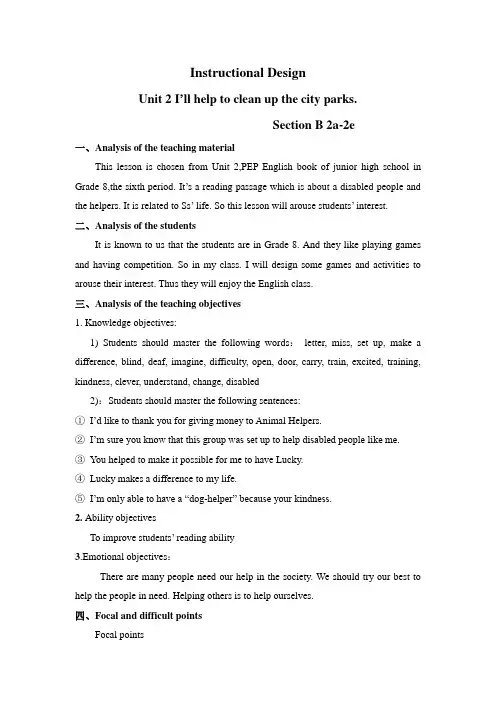
Instructional DesignUnit 2 I’ll help to clean up the city parks.Section B 2a-2e一、Analysis of the teaching materialThis lesson is chosen from Unit 2,PEP English book of junior high school in Grade 8,the sixth period. It’s a reading passage which is about a disabled people and the helpers. It is related to Ss’ life. So this lesson will arouse students’ interest.二、Analysis of the studentsIt is known to us that the students are in Grade 8. And they like playing games and having competition. So in my class. I will design some games and activities to arouse their interest. Thus they will enjoy the English class.三、Analysis of the teaching objectives1. Knowledge objectives:1) Students should master the following words:letter, miss, set up, make a difference, blind, deaf, imagine, difficulty, open, door, carry, train, excited, training, kindness, clever, understand, change, disabled2):Students should master the following sentences:①I’d like to thank you for giving money to An imal Helpers.②I’m sure you know that this group was set up to help disabled people like me.③You helped to make it possible for me to have Lucky.④Lucky makes a difference to my life.⑤I’m only able to have a “dog-helper” because your kindness.2. Ability objectivesTo improve students’ reading ability3.Emotional objectives:There are many people need our help in the society. We should try our best to help the people in need. Helping others is to help ourselves.四、Focal and difficult pointsFocal points1.To lean the new words and master the usage of them.2.To read the passage and get the main idea.Difficult pointsTo retell the passage.五、Teaching and learning methodsTeaching methods:3p teaching method; game teaching methodLearning methods: group work六、Teaching aidsMultimedia; magnets ; an apple tree picture七、Teaching procedures:Step 1 Warming up and revision1.DiscussionIf someone helps you,how do you usually thank him/her? Discuss this with a partner.2.Ask and answer( Before reading )Have you ever written a letter?Who do you write to?What do you usually write?Step 2 Presentation1.Lead inClass, listen and follow me please. Open your book to page 14. Is it easy or difficult for you to do this? Now imagine you are a disabled person, you can’t use your hands or arms.Try to open your book to page14.This time “Is it easy or difficult?”If you were a disabled person, what else is difficult?Ss answer…Today we will learn about a person who is disabled.2.Ask and answerWho is he? What’s wrong with him?Step 3 ReadingFast ReadingSay:Now let’s read a letter. What letter? Don’t worry. First,let’s read the questions and make sure we know the meanings of all the questions. Then read the passage quickly and find the answers to the questions.1) What kind of letter is it?2) Who wrote the letter to Miss Li? Why?3) Can you guess what’s the other part about? Who is Lucky?Students read the letter quickly and try to find the answers to the two questions. And thencheck the answers with the class.Which of the following shows the structure of the letter?Careful Reading1. T :Now let’s read these sentences about the letter. Read the passage again.. Read more carefully and finish 2dSubject(主语)Miss LiBen SmithLucky“AnimalHelpers” Verb (谓语) can get trains sent is Object (宾语) unable to move well. money to “Animal Helpers”. animals like lucky. things for disabled people.2. Check the answers with the class.3. Read para.2 and 3 and answer questions1)What was Ben’s life like be fore he had Lucky?2)How does Lucky help him?3)What does Ben think of Lucky?After readingRetell the passage using the mind-map.Step 4 DiscussionHow can we help people in our daily life? or what can we do to help people ?At school?Outside school?At home?Ask two groups of students to say their answers.Emotional education:The roses in her hand ,the flavor in mine. 赠人玫瑰,手有余香Step5 Homework1. Finish the exercises of Quan pin.2. Memorize the new words.Step 6 Blackboard designCan understand many English wordsorders。
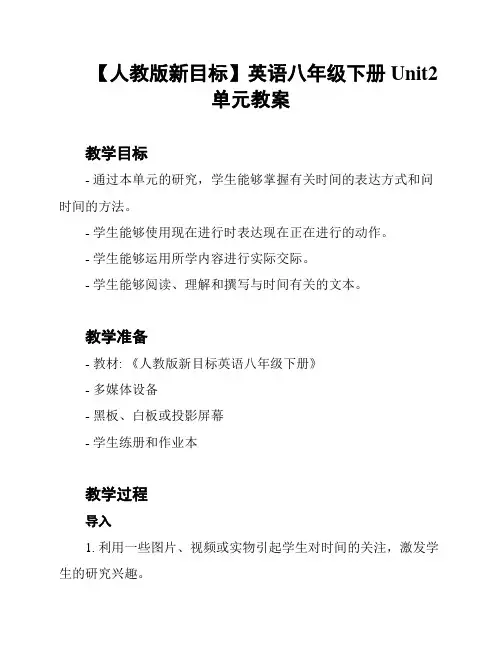
【人教版新目标】英语八年级下册Unit2
单元教案
教学目标
- 通过本单元的研究,学生能够掌握有关时间的表达方式和问时间的方法。
- 学生能够使用现在进行时表达现在正在进行的动作。
- 学生能够运用所学内容进行实际交际。
- 学生能够阅读、理解和撰写与时间有关的文本。
教学准备
- 教材: 《人教版新目标英语八年级下册》
- 多媒体设备
- 黑板、白板或投影屏幕
- 学生练册和作业本
教学过程
导入
1. 利用一些图片、视频或实物引起学生对时间的关注,激发学生的研究兴趣。
规范研究
1. 引导学生研究本单元的词汇和短语,对其进行拼读、理解和运用练。
2. 让学生听录音和跟读对话,掌握现在进行时表达现在正在进行的动作。
拓展研究
1. 带领学生进行交际练,让他们能够用英语问时间和回答时间的问题。
2. 分组进行对话练,加强学生的口语表达能力。
提升研究
1. 给学生分发阅读材料,让他们阅读并回答相关问题,加深对时间概念的理解。
2. 引导学生进行写作练,让他们写一篇短文描述自己一天的日常活动。
教学评估
- 通过学生的课堂表现和活动练,以及书面作业的完成情况来评估学生的掌握程度和进步情况。
教学延伸
- 建议学生在课后进行相关的阅读和听力练,加强对时间的理解和运用能力。
参考资源
- 《人教版新目标英语八年级下册教材》
- 互联网资源(如图片、视频、文章等)。
课时教案2022 年 2 月24 日星期四课题Unit 2 I'll help to clean up the city parks. (Section A 1a-2c)第 1 课时教学目标Teaching aims(教学目标)1.学会怎样主动提供帮助和做志愿活动2.能够熟练的运用本节课出现的动词短语Language points(语言点)要求掌握以下句式:I’d like to work outside.I hope to clean up the city parks.I volunteer to visit the sick children in the hospital.You could give out food at a food bank.要求掌握以下动词词组:cheer up come up with give out put off doing sthput up signs make plans help out with care for old peoplehand out call up sb write down教学重难点1.掌握“Would like to”“You could”句型。
2.掌握一定量的动词短语的用法。
教学过程1. Lead in(课堂导入)T: Look at the picture .What does the picture symbolize?Ss: Volunteering! / Volunteers!(如果学生回答有难度,老师可以多给一些提示,如There are people who offer their time to help others who are in need or in trouble. What do we call them?)(学生回答完之后,教师把“volunteer” 板书在黑板上,并解析“志愿者”)T: As a volunte er , what could you do to help others ? Now let’s open your books and turn to page 9. Let’s see what we could do to help people.教学设计说明:以图片和问题导入,激发学生的好奇心和兴趣,以此引入今天的话题。
新人教版八年级下册初中英语全册教案(教学设计)一. 教学目标本教案旨在帮助八年级学生掌握下册初中英语的相关知识和技能,包括听、说、读、写四个方面的能力提高。
二. 教学内容本教案涵盖了全册的教学内容,包括以下单元和主要教学点:1. Unit 1: Meeting New Friends- 语言点:be动词的一般现在时- 活动:介绍新朋友- 阅读:了解文化差异2. Unit 2: The First Day at School- 语言点:一般过去时- 活动:描述第一天上学的经历- 阅读:理解校园规则3. Unit 3: I Love Reading- 语言点:情态动词can和must - 活动:介绍喜欢的书籍- 阅读:阅读理解4. Unit 4: My School Life- 语言点:形容词比较级和最高级- 活动:描述学校生活的不同方面- 阅读:了解不同的学校生活5. Unit 5: Our Future Jobs- 语言点:职业相关词汇- 活动:谈论未来的职业- 阅读:了解不同的职业6. Unit 6: Weather and Climate- 语言点:天气相关词汇和短语- 活动:讨论天气和气候- 阅读:了解不同地区的气候7. Unit 7: Enjoy Your Trip- 语言点:旅行相关词汇和短语- 活动:计划和描述旅行- 阅读:阅读旅行指南8. Unit 8: At the Farm- 语言点:动词的现在进行时- 活动:描述在农场的经历- 阅读:了解农场生活三. 教学方法本教案使用多种教学方法,包括但不限于:听力练、口语对话、阅读理解、小组讨论、写作练等。
教师将根据具体情况选择合适的教学方法进行教学。
四. 教学步骤1. 引入新课,激发学生兴趣。
2. 执行听力练以提高学生听力能力。
3. 进行口语对话练,帮助学生提高口语表达能力。
4. 进行阅读理解练,加深学生对课文的理解。
5. 进行小组讨论,让学生互相交流观点。
八年级英语下册Unit2教案(精选4篇)八年级英语下册Unit2 篇1unit 8 topic 11. 1)so …that …如此…以至于….,that 引导的是结果状语从句,其结构是so +形容词或副词+that 从句。
2)so…that …可以换成such +(a/an)+形容词+名词。
2. would like 作为一个固定结构后接名词,代词,不定式作宾语,也可以用不定式作宾补,表示想要的意思。
1)would like sth. 想要某物;i would like some rice and pork 。
我想要一些米饭和猪肉。
2)would like to do sth. 想要做某事。
3)would like sb. to do sth. 想要某人做某事。
would like = want 想要1. be 为助动词,made 是及物动词make 的过去分词,of 后接宾语,be made of 的主语通常为成品。
be made from 后的原材料则看不出,be made in 主语是成品,介词in 后为产地,be made into 主语为原材料,介词into 后接成品。
the table is made of wood 。
这桌子是由木头制成的。
(可以看出原材料)paper is made from wood 。
纸是由木材制成的。
(看不出原材料)the comb is made in hong kong 。
这把梳子是香港制造的。
iron is made into knives 。
铁可以制成小刀。
2. afford 常接在can ,could ,be able to 之后,意为担负的起(…的费用,损失,后果等);抽的出(时间)。
afford 还有提供,给予,出产的意思。
3. on sale 上市;折价出售,减价出售。
for sale 待售,供出售。
7. (1)though 是从属连词,引导让步状语从句,和连词but 不能连用,但翻译时需译为但是。
人教版英语八下二单元教案Unit 2 Saving the Earth 教案。
Teaching Aims:1. To help students understand the importance of protecting the environment.2. To enable students to learn about different environmental problems and solutions.3. To encourage students to take action to protect the earth.Teaching Key Points:1. Vocabulary related to environmental protection and conservation.2. Understanding the causes and effects ofenvironmental problems.3. Discussing and debating different solutions to environmental issues.4. Encouraging students to take action to protect the environment.Teaching Difficult Points:1. Encouraging students to think critically about environmental issues and potential solutions.2. Encouraging students to take action in their daily lives to protect the environment.Teaching Procedures:Step 1: Warm-up (10 minutes)。
Unit 2 I’ll help to clean up the city parks.Section A 3a-3c教学设计Teaching aims:Knowledge aims: (1) Students can master the following words and language chunks: several, strong, feeling, satisfaction, joy, owner, journey, try out, give up several hours each week to help others,want to be an animal doctor, help him to get his future dream job, want to learn moreabout, how to care for animals, decide to try out for sth.(2) Students can read the article 3a and offer some help.Ability aims: Students can talk about volunteering and charities from interests, volunteer work, opinions andfeelings with the language chunks.Emotion aims: Students can understand how to offer help and take an active part in volunteering by this period.Don’t put it off, become a volunteer today. If everyone gives a little love, the world willbecome better and better.Teaching importance and difficulties:Importance: Students can talk about volunteering and charities from interests, volunteer work, opinions and feelings with the language chunks.Difficulties: Enable students to master the new words and language chunks, and then understand how to offer help and take an active part in volunteeringTeaching procedures:Step 1 Leading-in1. Sing the English song The song of Youth V olunteers.2. T: I’d like to join the volunteer project. I love to read about Chinese history. I volunteer at a ChineseHistory Club every Saturday afternoon. The kids are sitting around me, I tell stories about Chinesehistory, I’m happy. What about you? Now let’s make conversations in pairs like this.(多媒体展示)A: Would you like to join the volunteer project?B: …A: What do you love?B: I love…A: Where do you volunteer?B: I volunteer …A: What do you think of the work?B: I…3. T: I think your volunteer work must be helpful. Now let’s look at others.Step 2 Talk about the pictures and learn the new words.T: They are volunteers. They give up several hours each week to help others.Step 3 Reading 3aT: Just now we talked about volunteers. According to the pictures and title to predict what you will read in the article. (多媒体展示)What’s the passage mainly about?A. Mario Green wants to be an animal doctor.B. Mary Brown decided to try out for a volunteer after-school reading program.C. The volunteering of Mario Green and Mary Brown.1. Fast readingT: Read 3a and check your prediction.2. Careful reading. (请把下面问题的答案按要求逐次填入下表对应处,搭建表格)Read the whole passage and answer the following questions.①Where are Mario Green and Mary Brown from?②What do they love?③What could Mario and Mary volunteer to do?④What do they say about volunteering?3. Intensive readingRead the article in groups, underline the useful expressions, and then discuss in groups.1)Mario Green and Mary Brown from Riverside High School give up several hours each week to help others.give up several hours (汉语意思)2)I get such a strong feeling of satisfaction when I see the animals get better and the look of joy on their owners’ faces.a strong feeling of satisfaction(汉语意思)the look of(汉语意思)3)Last year, she decided to try out for a volunteer after-school reading program.try out for a volunteer(汉语意思)What does Mario Green love? (Animals)Where does he volunteer? (An animal hospital)What does he think of the work? (He gets a strong feeling of satisfaction when he sees the animals get better and the look of joy on their owner’s faces.) What does Mary Brown love? (Reading)Where does she volunteer? (Try out for a volunteer after-school reading program.)What does she think of the work? (She is going on a different journey with each new book.)4)Y ou can see in their eyes that they’re going on a different journey with each new book.going on a different journey(汉语意思)5)I can do what I love to do and help others at the same time.what I love to do作动词do的宾语。
at the same time(汉语意思)6)Underline the infinitives.作状语:Mario Green and Mary Brown from Riverside High School give up several hours each week tohelp others.She still works there once a week to help (状语) kids learn to read. (宾语)作宾语:Mario loves animals and wants to be an animal doctor.I want to learn more about how to care for animalsShe decided to try out for a volunteer after-school reading program.I can do what I love to do and help others at the same time.作宾补:Mario believes it can help them to get his future dream job.T: Look at the red words, can you find some rules? (动词不定式作宾语、宾补、状语)练习(一):见《自主学习与探究》P16 Ex.Ⅲ.练习(二):Read the sentences with the infinitives above, then fill in the following blanks.T: Do you understand the phrases given?4. Listen to the tape, pay attention to your pronunciation and intonation. Then read aloud.5. According to the chart above. Try to retell.Step 4 Summary.How to talk about volunteering? Step 5 Writing1. T: Just now we talked about the volunteer work. Now I’ll show you others’ volunteer work. Pleaseenjoy and guess : What kinds of volunteer work could we do? (多媒体播放后,打开学生思维,让学生尽情表达。